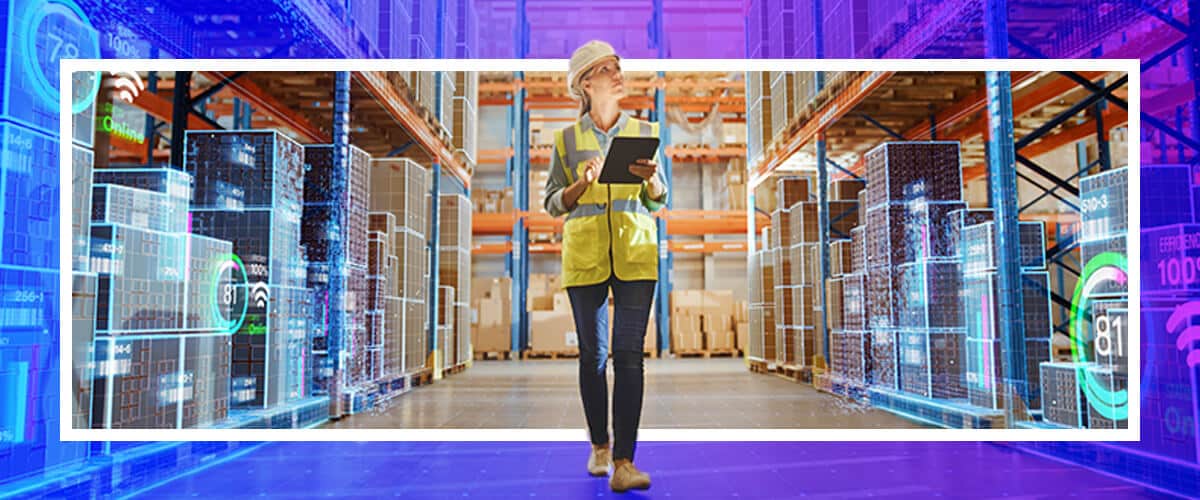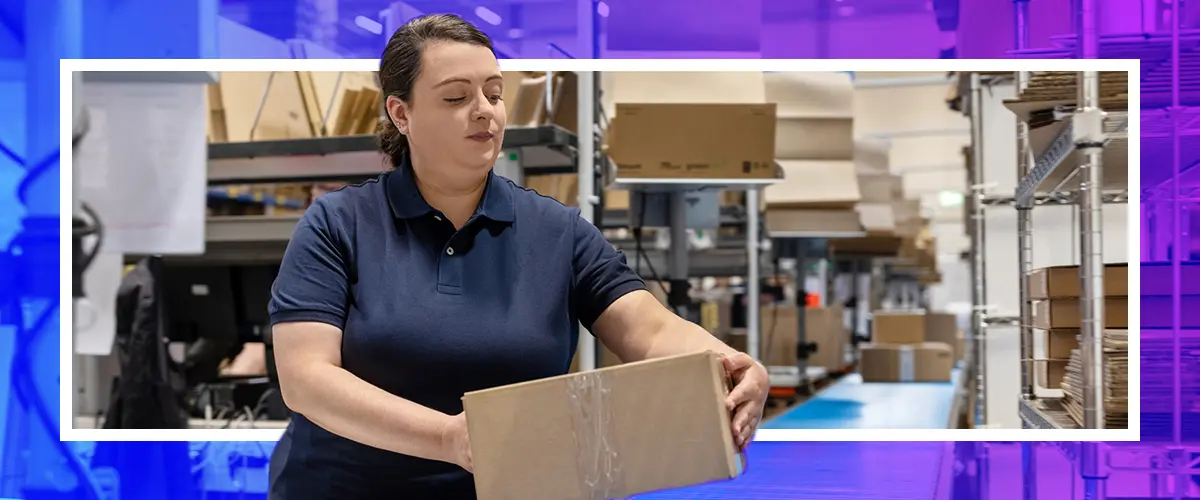Traditional fulfillment centers typically rely on slow, manual processes to drive warehouse workflows. The system is not built for the speed and scale to meet the demands of current ecommerce clients.
Today’s brands demand faster delivery and pinpoint accuracy. They want to scale on demand, and that’s something innovative warehousing technology can deliver effectively.
Smart warehousing technology is a digital upgrade for fulfillment operations, where IoT devices, AI, automation, and real-time data come together to streamline warehouse operations. Let’s explore the core technologies behind smart warehouses and discuss where things are headed, especially with warehouse management systems like Logiwa IO leading the way.
Contents
Key takeaways
- Smart warehousing uses AI, automation, robotics, and IoT technologies to facilitate fulfillment operations while lowering costs and allowing scalability.
- Automation allows more accurate labor planning during peak and off-peak periods, which helps warehouse managers avoid understaffing and overstaffing.
- Logiwa IO offers a scalable, cloud-based solution that integrates with sales channels and warehouse automation tools.
- Smart warehousing provides long-term value and future-readiness despite upfront costs and integration challenges.
What is smart warehousing technology?
Smart warehousing technology encompasses bringing intelligence and efficiency into the warehouse. It’s the integration of technological advancements like AI and robotics to optimize day-to-day warehouse operations.
Some technologies that are at play in these systems include:
- AI and machine learning: AI helps forecast demand and optimize product storage. Plus, it improves workforce planning by analyzing data to predict peak and slow periods.
- Warehouse management systems (WMS): A cloud-based and data-integrated WMS like Logiwa connects data from different processes and tools.
- Automation and robotics: These include conveyor belts, automated storage, and retrieval systems (AS/RS). Smart warehouse automation benefits include cost-savings and higher efficiency.
- IoT devices: Sensors, RFID tags, and barcode scanners facilitate real-time inventory and equipment tracking.
How smart warehousing is changing fulfillment centers
There was a time when human labor hand-picked items from the shelves and spent hours checking inventory in warehouses. Now, machines can handle much of the repetitive work that humans previously did. For example, robots assist with picking and packing orders, while conveyor systems move items without human intervention.
The increased involvement of technology in the warehouse has sped up things across the board. Orders now move through warehouses much faster, and the entire workflow is relatively smooth.
Another important differentiator in modern warehouses is real-time data visibility. Fulfillment teams can see exactly where the inventory is at all times. Automated systems also send them alerts in case there’s a shortage or delay. With such close monitoring, warehouse managers can plan and adjust operations while forecasting labor needs more accurately.
Warehouse teams can bring in more staff during peak seasons and let go of extra workers during the slow periods. The results are lower labor costs and higher efficiency.
For ecommerce brands and 3PLs, this technical shift has changed the game. They can meet customer demands promptly and keep things afloat even when disruptions occur. Plus, the use of AI in fulfillment centers often means that 3PLs have access to predictive insights that they can use to be prepared for the future.
Future trends in smart warehousing
AI and predictive analytics are leading the shift from traditional to smart warehouses. These technologies allow warehouses to forecast labor requirements and anticipate customer demands. Predictive AI also helps warehouses manage stock levels for varying demand periods.
Another significant trend is the expansion of IoT. The number of global IoT connections is estimated to reach 39.6 billion by 2033, a massive increase from 13.8 billion in 2022. IBM also forecasts that 5G will accelerate IoT applications by creating powerful computational environments.
In warehouse management, this would result in granular insights into every aspect of the workflow, such as equipment health. Warehouse managers can detect potential issues like equipment malfunction before they escalate to prevent downtime.
The future of smart warehousing will likely also include digital twins. Warehouse teams may create virtual replicas of physical warehouse environments to simulate different scenarios and prepare for them accordingly. Testing workflows in these environments will help warehouse managers reduce the risks associated with operational changes.
Companies have already started investing heavily in automation and smart warehousing. McKinsey reports, “In logistics and fulfillment, automation is expected to account for more than a third of capital spending, the largest fraction of any sector.”
Gartner also predicts that 50% of the companies “with warehouse operations will leverage AI-enabled vision systems to replace traditional scanning-based cycle-counting processes.”
Unlock a personalized tour of Logiwa IO
Logiwa’s smart warehousing technology
Logiwa IO, is an AI-powered, cloud-based fulfillment platform that facilitates high-volume operations. It offers features like dynamic wave and batch picking. In simple words, it automatically groups orders most efficiently for faster and less labor-intensive picking.
Since the platform offers real-time inventory sync across all connected sales channels, businesses can avoid overselling and minimize stockouts. The Logiwa fulfillment management system (FMS) features don’t end there.
For warehouses that have automated operations, Logiwa integrates directly with robotics and other systems. So, there’s always seamless coordination between the hardware and the software.
These features collectively help 3PLs and fulfillment centers move faster and reduce errors. They can also operate more cost-effectively by avoiding monetary losses associated with incorrect inventory levels and returns.
Challenges and considerations
The most evident challenge in smart warehousing is upfront costs. Warehouse teams may encounter significant initial investment for automation equipment, sensors, software, robotics, and so on. But much can be achieved with the automation provided by more affordable FMS like Logiwa IO.
Another challenge is integration, especially when it’s time to blend new technology with legacy systems. The lack of standardization across platforms can further complicate matters. Another challenge that can be mitigated with Logiwa IO’s powerful integrations.
Plus, automation sparks fears about job losses. However, the reality is more nuanced. While some manual roles may shift, there’s still a growing need for skilled workers to maintain smart warehouse systems. Warehouse managers can tackle these labor concerns by providing re-skilling initiatives and helping teams move into higher-value positions.
As warehouses become more connected, cybersecurity also becomes imperative. Teams need to protect customer data and inventory records. Warehouse managers need to invest in efficient data protection protocols and security systems.
As real as these challenges are, they are also manageable. Managers should see them as strategic investments to prepare their operations for long-term success.
Discover the power of smart warehousing
As we’ve covered, smart housing technology is a must-have for business competitiveness in the future. It brings along with it high speed, adaptability, scalability, and accuracy.
Decision-makers in 3PLs and high-volume brands should analyze their current fulfillment capabilities and opt toward tech-led solutions like Logiwa IO that can transform their operations and cut costs.
Looking to future-proof your fulfillment operations? Book a demo with our team to see smart warehousing in action.





